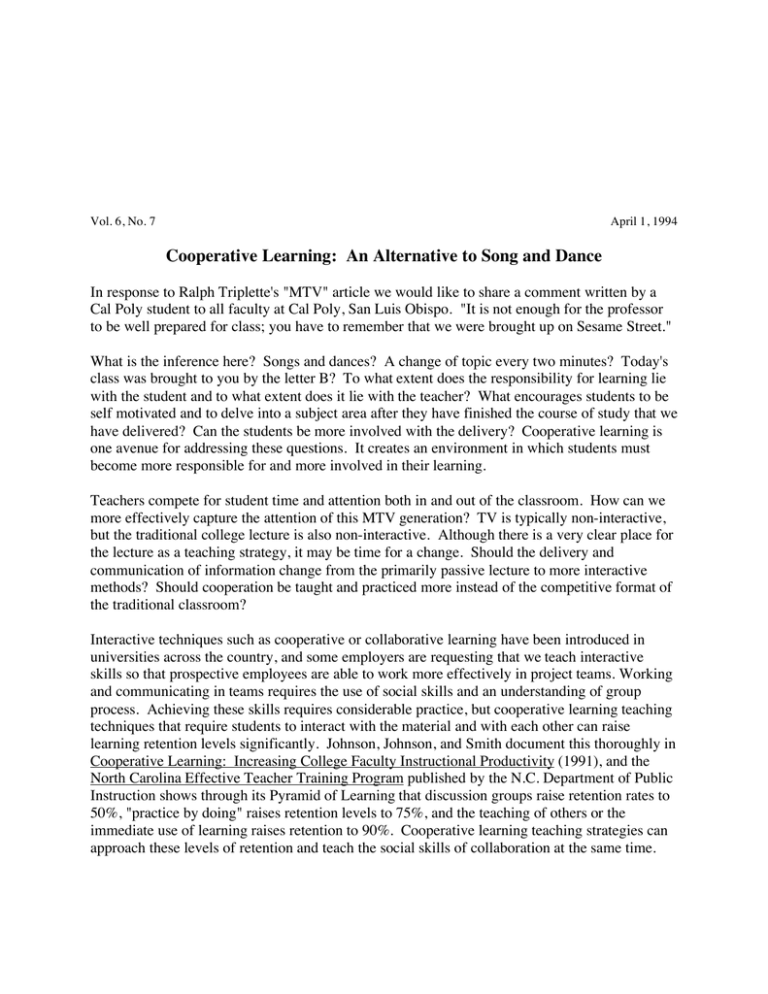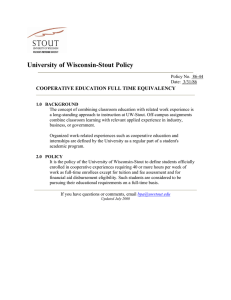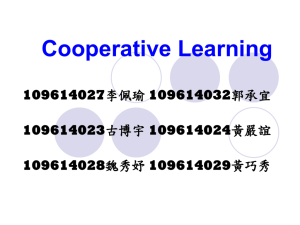Cooperative Learning: An Alternative to Song and Dance
advertisement

Vol. 6, No. 7 April 1, 1994 Cooperative Learning: An Alternative to Song and Dance In response to Ralph Triplette's "MTV" article we would like to share a comment written by a Cal Poly student to all faculty at Cal Poly, San Luis Obispo. "It is not enough for the professor to be well prepared for class; you have to remember that we were brought up on Sesame Street." What is the inference here? Songs and dances? A change of topic every two minutes? Today's class was brought to you by the letter B? To what extent does the responsibility for learning lie with the student and to what extent does it lie with the teacher? What encourages students to be self motivated and to delve into a subject area after they have finished the course of study that we have delivered? Can the students be more involved with the delivery? Cooperative learning is one avenue for addressing these questions. It creates an environment in which students must become more responsible for and more involved in their learning. Teachers compete for student time and attention both in and out of the classroom. How can we more effectively capture the attention of this MTV generation? TV is typically non-interactive, but the traditional college lecture is also non-interactive. Although there is a very clear place for the lecture as a teaching strategy, it may be time for a change. Should the delivery and communication of information change from the primarily passive lecture to more interactive methods? Should cooperation be taught and practiced more instead of the competitive format of the traditional classroom? Interactive techniques such as cooperative or collaborative learning have been introduced in universities across the country, and some employers are requesting that we teach interactive skills so that prospective employees are able to work more effectively in project teams. Working and communicating in teams requires the use of social skills and an understanding of group process. Achieving these skills requires considerable practice, but cooperative learning teaching techniques that require students to interact with the material and with each other can raise learning retention levels significantly. Johnson, Johnson, and Smith document this thoroughly in Cooperative Learning: Increasing College Faculty Instructional Productivity (1991), and the North Carolina Effective Teacher Training Program published by the N.C. Department of Public Instruction shows through its Pyramid of Learning that discussion groups raise retention rates to 50%, "practice by doing" raises retention levels to 75%, and the teaching of others or the immediate use of learning raises retention to 90%. Cooperative learning teaching strategies can approach these levels of retention and teach the social skills of collaboration at the same time. Often when we try interactive learning projects, students are placed in groups that are too large and students have no prior knowledge or practice in social interaction, group communication, or group process. The groups experience frustration and failure, some of which we don't see if we are not monitoring the group process. Without the ability to communicate in teams this frustration can also happen in the work place, so cooperative learning differs from "group work" in that group process and social skills are integrated with content into interactive learning exercises to enable the groups to function more effectively. Without these components most groups will become dysfunctional. There are five elements required to make Cooperative Learning successful: positive interdependency, individual accountability, face to face interaction, social skills, and group processing. Various techniques are required to make sure all these elements are included. This method of teaching requires that the teacher becomes more a facilitator of learning than a well-spring of information (though the teacher needs to be well informed as more searching questions naturally arise). There are potential pitfalls to the method. If any of the five elements are neglected, problems may occur. However, once students accept the method, their team skills improve, they study together after class so their motivation improves, they become more cooperative (a benefit to society in general once this becomes a norm), and according to a considerable amount of research they understand concepts more fully and retain more knowledge than from traditional lecture style instruction. It is possible to apply cooperative learning with large groups of up to 70 and, with adaptations, even more. Because the method differs significantly from more traditional teaching approaches and because there are possibilities of pitfalls on initial application, teachers should receive thorough training in cooperative learning techniques. Teachers should also create support groups for themselves (much as the students do in this type of learning) to help with unfamiliar ideas. There is such a support group at WCU--the Cooperative Learning Project Team supported by the FCTE. If you have any questions or an interest in this project team please call Maurice Phipps (3844) or Susan Kask (7401) for details. We should note that this method is not for everyone, but if you think it might suit your teaching style, look at some recent literature (available in the FCTE*) or chat with someone practicing this type of thing before "jumping" into it. Universities need to change from passive teaching methods as the most commonly used method in the classroom at this moment in time. As they say in cooperative learning circles, in an interdependent group we sink or swim together so support would be a necessary ingredient for change--don't start without it (including whoever will be evaluating your teaching!). Maurice Phipps, Parks & Recreation Mgt. and Susan Kask, Econ/Finance *There are two books in the FCTE library on Cooperative Learning: Cooperative Learning: Increasing College Faculty Instructional Productivity by David Johnson, and others; and Cooperative Learning by Spencer Kagan. Check these books out by visiting the FCTE. Comments or Questions? If you would like to make comments about this essay or ask questions of Maurice or Susan, please send your questions or comments by the 8th of the month to Terry Nienhuis (FCTE; phone: 7196; Vax: TNienhuis). Please indicate whether you are willing to be quoted or prefer to remain anonymous.





